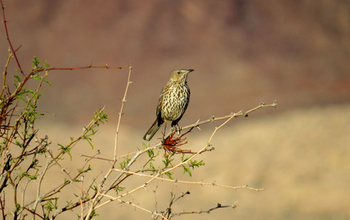Multimedia Gallery
Sage thrasher in lnyo County, California
A sage thrasher near Kelley's Well in lnyo County, California. Recent research shows that bird communities in parts of the Mojave Desert have collapsed over the past 100 years, most likely due to lower rainfall caused by climate change.
More about this image
A recent study by the University of California, Berkeley (UC Berkeley), has found that bird communities in the Mojave Desert straddling the California/Nevada border have collapsed over the past 100 years, most likely because of lower rainfall due to climate change.
A three-year survey of the area, which is larger than the state of New York, concludes that 30 percent, or 39 of the 135 bird species that were there 100 years ago, are less common and less widespread today. The 61 sites surveyed lost, on average, 43 percent of the species that were there a century ago.
"Deserts are harsh environments, and while some species might have adaptations that allow them to persist in a desert spot, they are also at their physiological limits," said Kelly Iknayan, who conducted the survey for her doctoral thesis at UC Berkeley. "California deserts have already experienced quite a bit of drying and warming because of climate change, and this might be enough to push birds over the edge. It seems like we are losing part of the desert ecosystem."
The collapse could have an impact on desert plants that rely upon birds to spread their seeds and for pollination, she said, as well as on a host of creatures that prey on the birds.
[This research is supported in part by grants from the National Science Foundation (NSF) (DEB 1457742 and DEB 1501757, and an NSF Graduate Research Fellowship, DGE 1106400).]
Read more about this research in the UC Berkeley news story Mojave birds crashed over last century due to climate change. (Date image taken: Photos taken between Feb. 16 and May 15, 2015; date originally posted to NSF Multimedia Gallery: April 15, 2019)
Credit: Chelsea Hofmeier
Images and other media in the National Science Foundation Multimedia Gallery are available for use in print and electronic material by NSF employees, members of the media, university staff, teachers and the general public. All media in the gallery are intended for personal, educational and nonprofit/non-commercial use only.
Images credited to the National Science Foundation, a federal agency, are in the public domain. The images were created by employees of the United States Government as part of their official duties or prepared by contractors as "works for hire" for NSF. You may freely use NSF-credited images and, at your discretion, credit NSF with a "Courtesy: National Science Foundation" notation.
Additional information about general usage can be found in Conditions.
Also Available:
Download the high-resolution JPG version of the image. (4.5 MB)
Use your mouse to right-click (Mac users may need to Ctrl-click) the link above and choose the option that will save the file or target to your computer.



 All images in this series
All images in this series